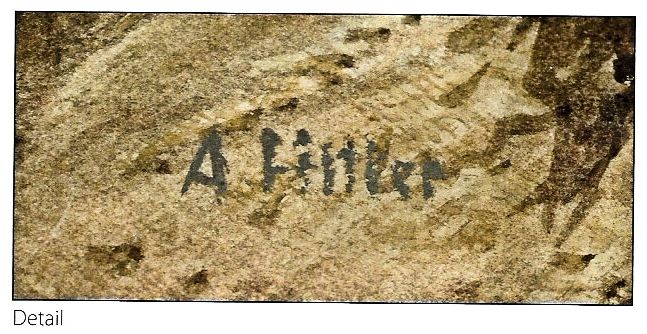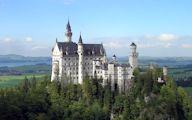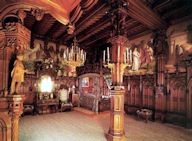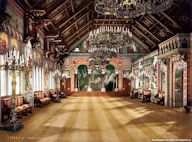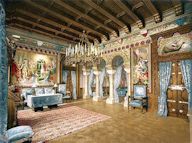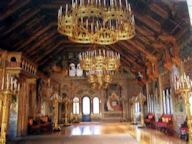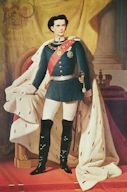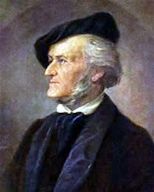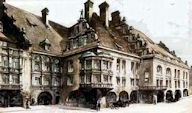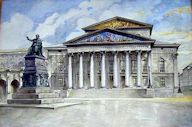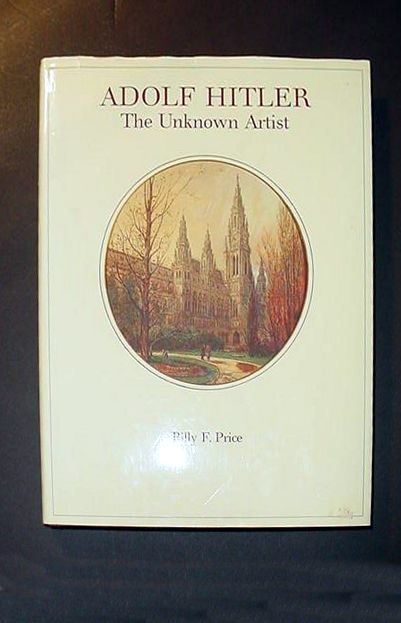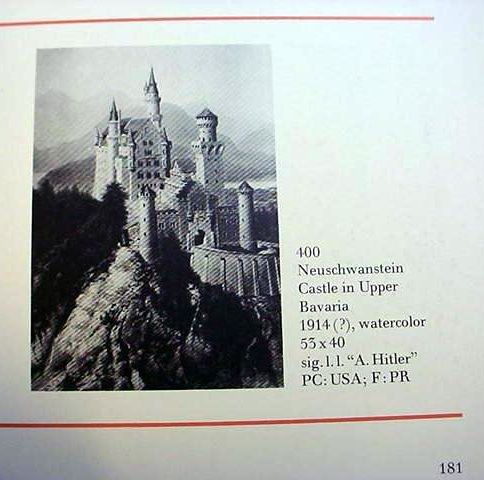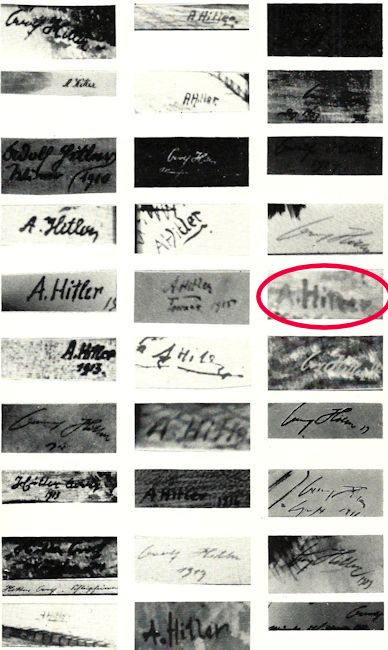|
|
|
|
Special Entry
Watercolor of Schloss Neuschwanstein by Adolf Hitler With Strong, Official Provenance and Expertise
|
|
|
|
|
|
|
|
| |
|
Watercolor by Adolf Hitler With Strong, Official Provenance and Expertise (Item AH 28-13; ART 17-22; SPECIAL ITEM) |
| DESCRIPTION: Recently, we were very fortunate to purchase two paintings by Adolf Hitler that are actually considered among his best. This first one shown here is an absolutely gorgeous rendering of the Castle of King Ludwig II of Bavaria—Schloss Neuschwanstein (New Swanstone Castle). This is a nineteenth-century Romanesque Revival palace. It was built by King Ludwig II as a devout homage to the great composer Richard Wagner, whom he practically worshipped. Therefore, it only follows that Adolf Hitler, who was also a devoted fan of the great Wagner would seek to honor him. It seems only logical, therefore, that New Swanstone Castle would be a natural for the young Hitler to paint at some time in his artistic career and, in my estimation, his infatuation with Wagner would have enthused him to positively strain to make this fantastic watercolor one of his finest works. The majesty of the castle as seen in Hitler’s painting is spellbinding and all who have seen it have praised it not only because it is Hitler’s work, but the painting itself emerges as a classic example of fine art of the Western world. Yes, it’s that great! Crude propagandist authors have said that Hitler was only a “house painter” before he became Germany’s leader. I am sure you have heard or seen that ignorant old canard more than once. Well, dear reader, this is one of the “houses” he painted. So just like all the other lies told about the German Führer this one needs to be trashed as well, wouldn’t you agree? We at Germania are proud as peacocks to offer this (dare I say: “masterpiece?”). “Yes, I dare!” Of all the watercolors painted by Hitler, this is one of the largest we have seen. The only full and significant literary work dealing with Hitler’s paintings is titled Adolf Hitler: The Unknown Artist by Billy F. Price, and this painting is shown on page 181 of the book and is listed as plate number 6/100. Where it is shown it says it was painted in 1914 and I think it may have been among the last renderings he produced before enlisting in the Bavarian Army and going off to war. He still found some time to paint a few Munich scenes during that period. Painting was his favorite thing in life and with high hopes, he took the examination to attend art school. To his complete disappointment, he and 85 other candidates failed the exam and were denied entrance to the prestigious Vienna Academy of Fine Arts. Today, we know that the test was stacked against the candidates; the required subjects of the exam were rather strange and the judges may have been rather prejudiced toward certain applicants from “select families.” We will never know, but when one views either of the paintings that we at Germania have procured and offer, there is not a shadow of a doubt that the young Adolf possessed a genius in architectural mastery in the arts. Just as he had opinions in the political arena and in the winning strategy in warfare (Blitzkrieg) his opinions and thoughts about art were strong and rather far beyond conservative. He believed strongly that “healthy art” had a “healthy soul.” He claimed it should be uplifting, noble, and idealistic. He considered certain themes such as the family, everyday work, mythology, rural life, and landscapes, the perfected human body, or the heroic soldier to be subjects worthy of art even though we know that depicting people was, as he admitted, not his specialty by any means. Of course, his ideas about the refinement of art seriously conflicted with the emerging schools of modern art forms, Impressionism, Cubism, Dadaism, et al. He claimed these terrible aberrations were produced by “scribblers, canvas crawlers, mental defectives, or cultural Neanderthals.” (Well put, Mein Führer!!!) Cicero said: “If we are not ashamed to think it, we should not be ashamed to say it.” So, I will say it also: “I agree with every word Hitler used in his critique of modern art.” Hitler’s architectural concepts were based upon his belief in “eternal values.” These values can be obviously perceived in his artistic works. These values contained mixed elements of classism, the renaissance, and the baroque all of which were amalgamated in the “Vienna Ring Style." This monumental expression of the 19th-century imperial power may well have been the most significant architectural feeling generated in Hitler’s youth. He was acutely impressed with so many masterpieces of the building sciences as could be seen in Vienna such as the Burgtheater, the Votive Church, city hall, and Theophil von Hansen’s great Austrian Parliament building. Hitler knew these buildings down to their finest details and painted them repeatedly. One of Hitler's favorites, which he painted several times, was Karlskirche, St. Charles’s Church, and this one also was one of the favorites of art researcher and authority Peter Jahn. This is the second Hitler canvas that we offer and is an original rendering of Karlskirche. Peter Jahn of Vienna and Dr. August Priesack were considered the leading experts able to authenticate the paintings of Adolf Hitler. In 1935, the historical section of the NSDAP official archives in Munich was assigned the systematic task of locating and certifying the paintings of Adolf Hitler. Two archivists, Wilhelm Dammann and Dr. August Priesack, worked together and were responsible for authenticating all Hitler artwork that could be traced, purchased, or borrowed. The actual search for the art was carried out by staff members under the auspices of Hitler’s deputy Rudolf Hess. One authority that I mentioned earlier was Peter Jahn. He and Dr. Priesack were the last surviving experts in the NSDAP search for Hitler’s art. Jahn had many conversations with Hitler considering art in general, but particularly the Führer’s own art. With this painting of the castle there is an official letter of authenticity from Peter Jahn regarding this watercolor in detail. Jahn recalls a conversation with the Reich’s Chancellor himself regarding this particular work, as actually being the largest surviving watercolor by Hitler. The work is in fine condition and measures 23.5 x 15.5 inches. After the war, Jahn resumed his consulting career with no thoughts of his former activities on behalf of the Hess staff. When his name was mentioned in a magazine article in 1960, however, he received inquiries from all over the world and agreed to serve as personal advisor to the English Marquis of Bath when the latter began his large, personal collection. Through his knowledge of Hitler’s Viennese style and subject matter and his numerous contacts in Vienna, Jahn has long been an authority on the subject and has traced and authenticated numerous paintings. His files and references were particularly useful to author Billy Price in writing his great hornbook on the subject Adolf Hitler: The Unknown Artist. Today, this book is one of the few works that covers the subject so thoroughly and interestingly. Both the paintings we acquired are shown in the book, but the Schloss Neuschwanstein canvas is unfortunately depicted in the noncolor section of the book; the St. Charles’s Church in winter, though, is shown in a large picture on page 49 of the price book. Hitler will forever be one of the most famous leaders in the history of mankind and the mystique and fascination surrounding him seem completely unending and if anything, he seems to be becoming more and more popular with his book Mein Kampf clocking a banner digital year in 2013 and 2014 when it became an e-book bestseller on Amazon. The Kindle version of Mein Kampf was ranking way up there on the politics and current events far outpacing books by modern day neoconservatives such as Sarah Palin, Charles Krauthammer, and Glenn Beck. So, if the book and the popularity of his artwork tell us anything beyond what is recorded in the pages of the dubious horror stories out there, it may just occur to some readers today that here was a remarkable individual and artist (a very talented artist) who turned into a “reluctant politician” and military leader whose ultimate aim was the preservation and advancement of his Fatherlands (Germany and Austria) and the creation of a “Great Art” and the preservation and protection of the Aryan culture and architecture. From time to time, we see Hitler’s artistic watercolors being offered in the $10,000 range. In fact, this is a huge underestimate and can only be applied to paintings that are probably fakes or have little or questionable provenance. Genuine Hitler watercolors with good provenance from August Priesack or Peter Jahn have sold from reputable auction house for between $50,000 and $90,000 over the past ten years with about $50 thousand to $60 thousand being brought for an average one in 2011-2013. The two we offer are far beyond average. The authors of several books by persons who sought to denigrate the Führer would invariably show his poorest paintings in their books to portray his works and the renderings as what they dubiously called a “lifeless art form.” So in essence, we are genuinely thrilled to bring forward to you these virtual masterpieces from the brush of the Führer. Not exactly lifeless, are they?! PRICE: SOLD |
Contact Us
Please E-mail for any additional information you may need.
If you prefer, contact 'Germania' at PO Box 68, Lakemont, GA 30552
or call at 706.782.1668.
Please! do not call during the wee hours of the morning. The best time for calling us is between 10 am and 12 noon and between 9 and 11 pm eastern time.



